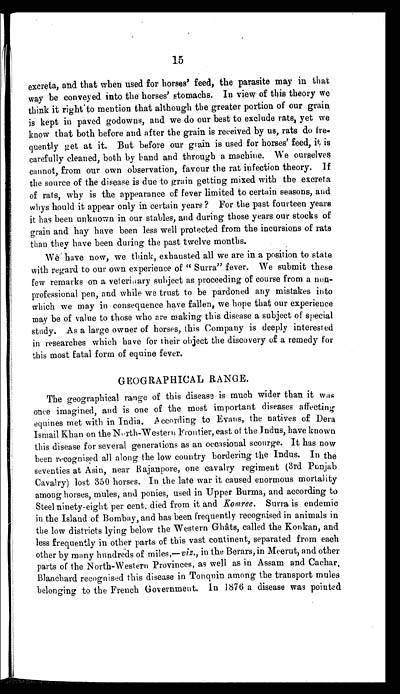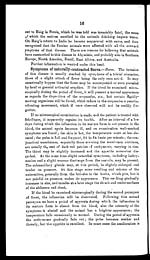Medicine - Veterinary > Civil Veterinary Departments > Civil Veterinary Department ledger series I-VI > Volume IV - Horse surra
(419) Page 15
Download files
Individual page:
Thumbnail gallery: Grid view | List view

15
excreta, and that when used for horses' feed, the parasite may in that
way be conveyed into the horses' stomachs. In view of this theory we
think it right to mention that although the greater portion of our grain
is kept in paved godowns, and we do our best to exclude rats, yet we
know that both before and after the grain is received by us, rats do fre-
quently get at it. But before our grain is used for horses' feed, it is
carefully cleaned, both by band and through a machine. We ourselves
cannot, from our own observation, favour the rat infection theory. If
the source of the disease is due to grain getting mixed with the excreta
of rats, why is the appearance of fever limited to certain seasons, and
whys hould it appear only in certain years? For the past fourteen years
it has been unknown in our stables, and during those years our stocks of
grain and hay have been less well protected from the incursions of rats
than they have been during the past twelve months.
We have now, we think, exhausted all we are in a position to state
with regard to our own experience of "Surra" fever. We submit these
few remarks on a veterinary subject as proceeding of course from a non-
professional pen, and while we trust to be pardoned any mistakes into
which we may in consequence have fallen, we hope that our experience
may be of value to those who are making this disease a subject of special
study. As a large owner of horses, this Company is deeply interested
in researches which have for their object the discovery of a remedy for
this most fatal form of equine fever.
GEOGRAPHICAL RANGE.
The geographical range of this disease is much wider than it was
once imagined, and is one of the most important diseases affecting
equines met with in India. According to Evans, the natives of Dera
Ismail Khan on the North-Western Frontier, east of the Indus, have known
this disease for several generations as an occasional scourge. It has now
been recognised all along the low country bordering the Indus. In the
seventies at Asin, near Rajanpore, one cavalry regiment (3rd Punjab
Cavalry) lost 350 horses. In the late war it caused enormous mortality
among horses, mules, and ponies, used in Upper Burma, and according to
Steel ninety-eight per cent. died from it and Komree. Surra is endemic
in the Island of Bombay, and has been frequently recognised in animals in
the low districts lying below the Western Ghâts, called the Konkan, and
less frequently in other parts of this vast continent, separated from each
other by many hundreds of miles,—viz., in the Berars, in Meerut, and other
parts of the North-Western Provinces, as well as in Assam and Cachar.
Blanchard recognised this disease in Tonquin among the transport mules
belonging to the French Government. In 1876 a disease was pointed
Set display mode to: Large image | Zoom image | Transcription
Images and transcriptions on this page, including medium image downloads, may be used under the Creative Commons Attribution 4.0 International Licence unless otherwise stated. ![]()
| India Papers > Medicine - Veterinary > Civil Veterinary Departments > Civil Veterinary Department ledger series I-VI > Horse surra > (419) Page 15 |
|---|
| Permanent URL | https://digital.nls.uk/75517147 |
|---|




